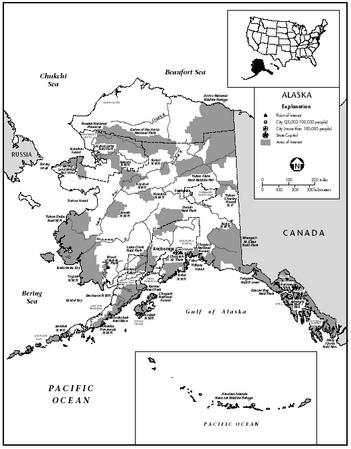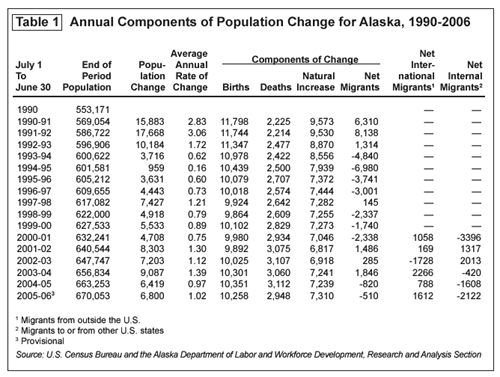Alaska - Ethnic groups
In 2000 Native Americans accounted for 15.6% of Alaska's population—the highest percentage of any state. Indians—primarily Athabaskan (14,520) and Tlingit-Haida (14,825)—living in southeastern Alaska (Alaska Panhandle) numbered around 29,345 in 2000. There are also small numbers of Tsimshian living in this area. Eskimos (45,919) and Aleuts (11,941), the other native peoples, live mostly in scattered villages to the north and northwest. Taken together, Alaska Natives were estimated in 2000 to number about 98,043, up from 86,000 (16%) in 1996. The Native Claims Settlement Act of 1971 gave 13 native corporations nearly $1 billion in compensation for

In 2000, the black population was 21,787, or 3.5% of the total population, down slightly from 22,000 in 1990. Among those of Asian origin in 2000 were 12,712 Filipinos, 1,414 Japanese, and 4,573 Koreans; in the same year, the total Asian population was 25,116 and Pacific Islanders numbered 3,309. In 2000, of Alaska's total population, about 25,852 individuals were of Hispanic or Latino origin, with 13,334 of those claiming Mexican ancestry (up from 6,888 in 1990). Foreign-born persons numbered 37,170, or 5.9% of the population (up from 4.4% in 1990).
Alaska's statewide population increased by 6.6 percent, or 42,520 people, in the six years from July 1, 2000-July 1, 2006, based on new population estimates released in December 2006 by the U.S. Census Bureau.
The Alaska Department of Labor and Workforce Development utilized the federal figures to calculate growth estimates released today for the state and by boroughs, census areas and places.
The State of Alaska
The population gain in Alaska was slightly faster than the 5.9 percent growth in the same period for the United States as a whole. The number of people living in the state climbed from 627,533 at the time of the July 1, 2000, to a provisional July 1, 2006, estimate of 670,053 (see Table 1).

Alaska's rates of change were an annual average of 1.1 percent per year for 2000-2006 and 1.0 percent for 2005-2006. Alaska is still number 47 in terms of population, larger than North Dakota, Vermont, the District of Columbia and Wyoming.
Currently growth in Alaska as a whole is primarily through natural increase. From July 1, 2000, to July 1, 2006, Alaska's natural increase (births minus deaths) added 42,571 people, while net migration (in-migration minus out-migration) accounted for a loss of 51 people. During 2005-2006, Alaska added 7,310 people through natural increase and lost 510 people to out-migration.
In the early 1990s, Alaska added about 9,600 people each year through natural increase. A gradual decline in fertility and a gradual increase in mortality tied to an aging population have resulted in a slowdown in natural increase to about 7,300 persons per year.
http://www.sitnews.us/0107news/012507/012507_alaska_population.htmlNewborns account for state population growth
The population in Alaska reached an estimated 679,720 people as of July last year, the state said Monday.The population was up 0.8 percent from a year earlier, or 5,210 more people, according to Greg Williams, the state demographer. That change reflected 7,770 more births than deaths during the year, and 2,560 more people leaving the state than moving to Alaska, he said.
Williams said the Alaska population has grown 8 percent since 2000, or 52,187 people, the same percentage growth as the U.S. population showed.
Among communities in Alaska, the estimated populations last July were as follows:
• Anchorage, 284,994 people, up 0.9 percent from a year earlier.
• Mat-Su, 82,515 people, up 3.5 percent.
• Kenai Peninsula Borough, 52,990 people, up 1.7 percent.• Fairbanks North Star Borough, 89,896 people, down 1.6 percent.
• Juneau, 30,427 people, up 1 percent.
The greatest population growth last year came in the Denali Borough near Denali National Park. The estimated population was 1,848 people, up 4.8 percent.
The greatest decline was in Yakutat, with 592 people, down 4.3 percent.
Williams said that troops based in Alaska but deployed overseas are counted as being in Alaska in his estimates. "This means that the populations for the Fairbanks North Star Borough and the Municipality of Anchorage, where the main Alaska military bases are located, as well as other communities with a substantial National Guard presence, may be somewhat lower than these estimates indicate, depending on the current deployment of military and National Guard personnel," he said.
http://www.adn.com/news/alaska/story/725332.htmlImmigration and Naturalization Operations in Alaska
Since 1980 there have been over twenty-five pieces of federal legislation affecting immigration and naturalization, including comprehensive acts passed in 1986, 1990 and 1996 and the national security legislation passed after the terrorist attacks of September 11, 2001. The overall effect of the legislation of the past two decades has been to place heightened controls on admission to the U.S. and to broaden the powers of law enforcement agencies in arresting and detaining foreigners. The legislation has been tied to, or paralleled, both national welfare reform and crime control efforts, particularly drug control—with much of the legislation in the 1990s reflecting a concern with aliens and criminal behavior and aliens and financial responsibility. Since 9/11, the concern has been terrorism.
The most recent data providing an overview of the work of forestalling illegal immigration and facilitating legal admission to the U.S. come from the former Immigration and Naturalization Service. Until this spring, INS bore primary responsibility for structuring immigration; facilitating naturalization—the process of acquiring citizenship—and arranging for the deportation of those who enter the country illegally. With the birth of the Department of Homeland Security, these functions have been split up and placed under several bureaus in the new department. (See accompanying article “Reorganization of INS.”) The data presented here reflect the old configuration.
In Alaska, the functions of the INS have been administered from Anchorage, where the district headquarters is located. As with most government operations here, INS functions involve relatively few people over a vast area. The agency has administered essentially the same range of programs and operations here as in more densely populated states, including enforcement operations.
The data in this article in general cover INS operations from FY 1999 through FY 2001—just beyond the date of the terrorist attacks. (The federal fiscal year ends September 30.) In addition, because of the reported broader use of detention powers by law enforcement in the months since 9/11, the article also presents figures on INS detention operations for Alaska through FY 2002.
Immigration and Naturalization
In FY 2001 the INS recorded the admission of 1,401 legal immigrants who declared Alaska as their intended state of residence. The most sizeable national groups came from the Phillippines (366), Mexico (126), Canada (94), Russia (89), and Korea (79).
There is a complex structure of categories and regulations governing naturalization, but in general legal immigrants are eligible to become U.S. citizens after five years of residency in the country. In Alaska, in FY 2001, 710 people were naturalized. Of these, the most sizeable national groups came from the Philippines (170), Korea (87) and Mexico (60).
